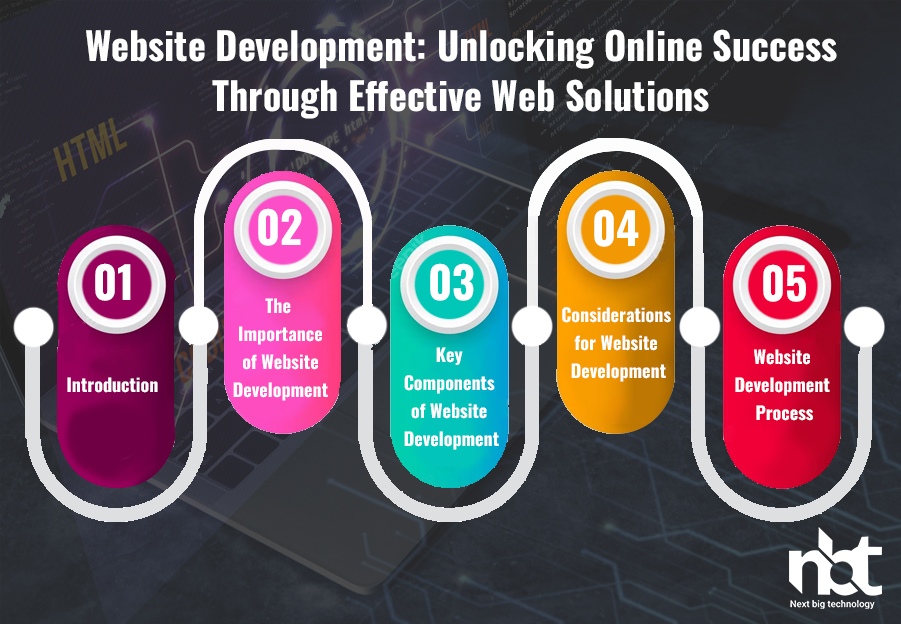Table of Contents
Introduction
In today’s digital era, a well-designed and functional website is crucial for businesses of all sizes. Websites serve as the virtual storefronts, providing a platform for businesses to showcase their products, services, and brand identity to a global audience. Whether you’re a small business owner or an aspiring web developer, understanding the world of website development is essential for establishing a strong online presence.
In this blog post, we will explore the intricacies of website development, covering its importance, key components, and considerations. Whether you’re planning to create a website for your business or looking to expand your knowledge in web development, this comprehensive guide will provide valuable insights into the process of building successful websites.
-
The Importance of Website Development
In today’s digital-first landscape, a website is a crucial tool for businesses to establish credibility, attract customers, and generate revenue. Websites serve as the central hub for online marketing efforts, enabling businesses to showcase their offerings, share valuable information, and engage with their target audience.
-
Key Components of Website Development
2.1. Planning and Strategy Website development starts with a solid plan and strategy. This includes identifying goals, target audience, and desired functionalities. Planning ensures a clear roadmap for the development process and helps align the website with the business objectives.
2.2. Web Design and User Experience (UX) Web design plays a vital role in creating visually appealing and user-friendly websites. The design should reflect the brand identity, incorporate intuitive navigation, and provide a seamless user experience. Attention to UX principles, such as responsive design and accessibility, enhances user engagement and satisfaction.
2.3. Content Creation and Management Compelling and informative content is essential for engaging visitors and driving conversions. Website development involves creating and managing content, including text, images, videos, and other media. Content management systems (CMS) enable easy content updates and allow businesses to maintain a fresh and relevant website.
2.4. Front-End Development Front-end development focuses on the visible components of the website. It involves coding HTML, CSS, and JavaScript to create the layout, styling, and interactivity of the website. Front-end development ensures that the website is visually appealing, responsive, and functional across different devices and browsers.
2.5. Back-End Development Back-end development deals with the server-side functionality of the website. It involves programming languages such as PHP, Ruby, Python, or JavaScript (Node.js) to handle data processing, database integration, user authentication, and other server-side operations. Back-end development ensures that the website performs efficiently and securely.
2.6. Search Engine Optimization (SEO) Effective website development incorporates SEO practices to improve visibility and organic traffic. SEO involves optimizing the website’s structure, content, and meta tags to rank higher in search engine results. By implementing SEO techniques, businesses can attract relevant traffic and increase their online presence.
-
Considerations for Website Development
3.1. Target Audience and User-Centric Approach Understanding the target audience is crucial for website development. A user-centric approach ensures that the website addresses the needs and preferences of the target audience. Conducting research, creating user personas, and incorporating usability testing contribute to a better user experience.
3.2. Responsive Design and Mobile Optimization With the increasing use of mobile devices, responsive design has become a necessity. Websites should be optimized for various screen sizes, ensuring a seamless experience across desktops, tablets, and smartphones. Mobile optimization improves user engagement, boosts SEO rankings, and expands the reach of the website.
3.3. Security and Data Protection Website security is paramount to protect user data and prevent security breaches. Implementing secure coding practices, using HTTPS protocols, regularly updating software and plugins, and incorporating measures such as SSL certificates and firewalls help safeguard the website and user information.
3.4. Performance Optimization Website performance directly impacts user experience and search engine rankings. Optimization techniques, such as caching, minification of files, image compression, and efficient code structure, improve loading speed and overall performance. Regular performance testing and monitoring ensure optimal website functionality.
3.5. Scalability and Future Growth Considering scalability is essential to accommodate future business growth and changing needs. The website’s architecture should be designed to handle increased traffic, content updates, and additional features. Scalability allows for seamless expansion without significant disruptions to the website’s functionality.
-
Website Development Process
4.1. Requirement Gathering and Planning The development process begins with gathering requirements and understanding the business objectives. This includes identifying target audience, desired features, and technical specifications. Planning involves creating wireframes, sitemaps, and content strategies to outline the website’s structure and functionalities.
4.2. Design and Development The design phase involves creating the visual elements, UI/UX, and prototypes based on the project requirements. Once the design is finalized, the development phase begins, where front-end and back-end technologies are employed to bring the website to life. Iterative development, continuous testing, and collaboration between design and development teams ensure a smooth development process.
4.3. Content Creation and Integration During this phase, content is created and integrated into the website. It includes writing and optimizing web copy, selecting and editing images and videos, and organizing content within the CMS. Content integration ensures that the website’s design and functionality align with the intended messaging and user experience.
4.4. Testing and Quality Assurance Thorough testing is crucial to identify and resolve any issues or bugs in the website. This includes functionality testing, cross-browser compatibility testing, performance testing, and user acceptance testing. Quality assurance ensures that the website meets the highest standards of functionality, usability, and performance.
4.5. Deployment and Maintenance Once the website passes testing and quality assurance, it is deployed to the live server. This involves setting up hosting, configuring domain settings, and ensuring proper server and database configurations. Ongoing maintenance, including regular updates, security patches, and performance monitoring, is crucial to keep the website running smoothly.
-
Conclusion
Website development is a multifaceted process that encompasses planning, design, development, and ongoing maintenance. A well-developed website is not only a powerful marketing tool but also a gateway to business success in the digital age. By understanding the importance of website development, considering key components, and following a structured development process, businesses can create effective and impactful websites that attract visitors, engage users, and drive growth in the online realm.












